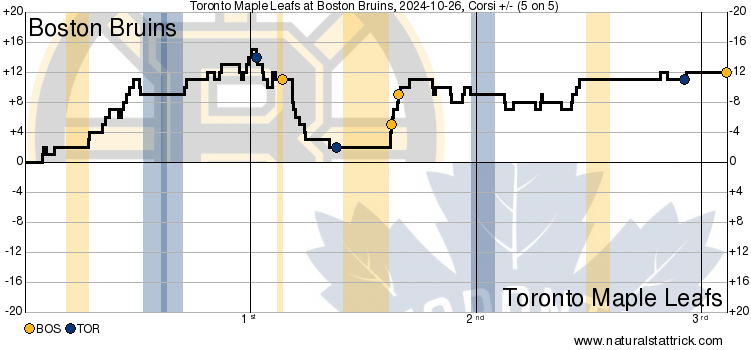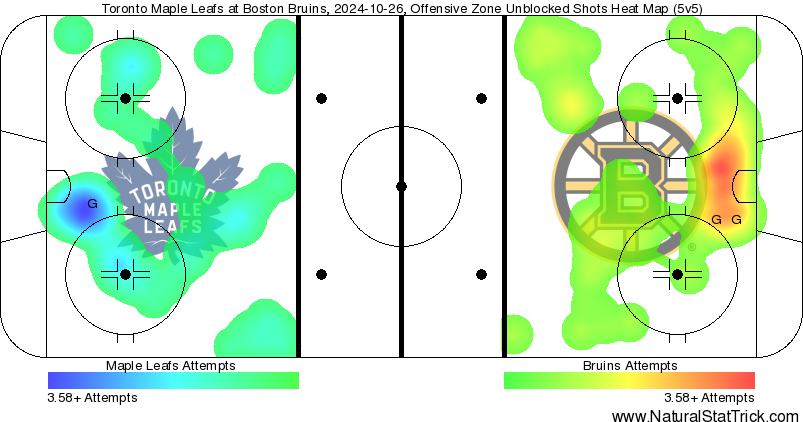The Maple Leafs forfeited 1-0 and 2-1 leads, managed to salvage a point thanks to Auston Matthews, and also lost the extra point thanks to Auston Matthews in yet another loss to the Boston Bruins.
Your game in 10:
1. After getting outscored 11-3 versus two non-playoff teams this week, the Leafs needed a response, starting with a strong road period in a tough building/infamous house of horrors. Here were the five-on-five numbers after 20 minutes:
- 21-7 shot attempts in favour of Boston
- 12-3 scoring chances in favour of Boston
- 10-2 shots in favour of Boston
Mix in two unsuccessful (overlapping) power play attempts, and it looked dire for the Leafs after the opening frame.
The Leafs‘ first six minutes, leading up to the end of their first PK, were actually just fine. The pace of the game was high early on. William Nylander created a half-chance out of nothing by forcing a turnover out of David Pastrnak. Nick Robertson and Max Pacioretty couldn’t quite connect on an odd-man rush, with the net empty for Robertson. Neither resulted in a shot on goal, but there were a couple of chances, and the pace was crisp.
Coming off of a (soft) Ryan Reaves interference penalty, a post-PK line of McMann – Tavares – Robertson, plus a McCabe-Myers pairing, had a terrible go of it in their own zone, turning pucks over repeatedly (two mishandles by McMann, another McCabe between-the-legs pass attempt). The Leafs struggled to fully recover for a few shifts. All of a sudden, the shots were 6-0 Boston.
2. When the first power-play opportunity arrived at the midway point of the first (Reaves drew an interference call forechecking in the offensive zone), John Tavares lost the draw clean for an immediate Boston clear — a noteworthy storyline amid the early power-play struggles. One of the best faceoff men in the league (Tavares) is currently 13 for 29 with the man advantage (45%), which is bound to improve over time but is a factor in the terrible start.
The Leafs, when attempting the zone-entry kick-to-the-wall on both the left and right sides, threw the puck away on the two subsequent entries, via Tavares and Mitch Marner. The top unit didn’t make it to the one-minute mark before they were off the ice.
Tavares’ turnover was worse than Marner’s, as Marner was under much more pressure, but the Leafs continue to struggle with this entry play. Tavares — this is written knowing he made a great pass for a goal off of the entry at 6-on-5 late in the game — has generally struggled in this department so far this season, and whether they need to change this up is clearly a conversation worth having (frankly, so is whether Matthew Knies should be on the top PP in Tavares’ place altogether, at least for the time being).
One part of the equation is making better decisions with the puck rather than forcing a play into the middle for a turnover. The other half is that the Leafs need the initial puck carrier, usually Matthews or Nylander, to mix in more variety and deception—whether it’s holding onto the puck or chipping it behind and skating onto it—when the PKers are pushing right up on them inside the line.
Sometimes, they’re kicking it to the wall on autopilot without reading the entry defense, and it becomes really predictable, failing to draw in the defender or open any space. Prior to the Marner turnover, Nylander had an easy opportunity to flip it behind the Bruins defense and then skate onto it with speed. Instead, Marner ended up in a tough situation on the wall, with the Bruins pushing up aggressively on him. Matthews called his own number in a similar situation to Nylander’s against the Blues and nearly scored on a breakaway, but, by and large, they just default to the predictable entry play, and opposing PKs are all over it.
3. With the PP winding down and nothing doing on it for the Leafs, Max Domi drew a penalty, giving the Leafs a little over 30 seconds of a 5-on-3. This time, Tavares won the draw, and the Leafs moved it around well and created some real looks. On arguably the best one, Mitch Marner egregiously over-passed:
— ًًً (@icenineleafs) October 26, 2024
Not much to say here other than the obvious.
4. The second period started with a bang just 35 seconds in, courtesy of Matthew Knies, who continued his excellent start to his sophomore NHL season with his fourth goal.
After he initially gained the zone, Knies’ pass attempt was off the mark, but Auston Matthews did a great job recovering the puck on the boards and then attacking the net directly off the wall, dragging three defenders with him. Knies headed straight to the front of the net, lifted a stick away from the puck, then stuck with the play after Matthews was dispossessed initially, seizing on the loose puck first and burying.
Knies 4th of the Season vs Bruins courtesy of @Bonsie1951 and @Jim_Ralph. @LeafsJelly pic.twitter.com/H99AN6eUnD
— Maple Leafs Hotstove (@LeafsNews) October 27, 2024
The difference in the maturity of Knies’ game this October compared to early last season, when he was starting his first-ever NHL regular season in a big role against top competition on the Matthews line, is really noticeable in the first few weeks of the season (building on last spring’s playoffs). He’s throwing his weight around consistently on the forecheck, winning most of his battles in the dirty areas, and providing an effective net-front presence. More confident in himself and the role he’s serving on the line — and even bigger physically after this past offseason — Knies has been the team’s most consistent forward through nine games.
5. An undisciplined Jake McCabe interference penalty just two minutes later led to the Leafs surrendering their lead.
This power-play goal was too easy for the Bruins, who created a down-low 2v1 that David Pastrnak finished off. Between Benoit (who was a little overextended after pressuring the half wall) and Matthews, the Leafs needed to collapse and take the space away a little quicker/better, as Tanev — who could’ve played it a little better — was in a tough spot defending a 2v1 with a lot of space through the low slot. Brad Marchand was able to take the pass down low, take a stride out front, and then make an easy pass to the backdoor to the biggest shooting threat on the Bruins’ power play.
There was a very similar play on the Leafs’ double-minor kill later in the period — which was otherwise excellent — where there was a lot of time and space for a down-low 2v1, but fortunately, Zacha’s pass to Pastrnak was a little off the mark.
6. The Leafs struggled to create much at five-on-five in this game, but when Oliver Ekman-Larsson — who continues to be a real factor in the physical department, mixing it up regularly — was sent to the box along with Charlie Coyle for some four-on-four action, Mitch Marner made his nicest play of the young season.
Marner gained the line through traffic, threw it in reverse to the top of the offensive zone, and found Rielly, who was jumping up. The pass was right in the sweet spot for a one-timer — a brilliant pass from Marner and a good finish by Rielly for his second of the season.
"MORGAN RIELLY CELEBRATES HIS 800TH GAME WITH A GOAL!"
Rielly 2nd of the Season vs Bruins courtesy of @Bonsie1951 and @Jim_Ralph. @LeafsJelly pic.twitter.com/dhI4K3ZGoR
— Maple Leafs Hotstove (@LeafsNews) October 27, 2024
Since last season, the Leafs have outscored the opposition 6-1 at four-on-four, which is tied for the best differential in the league. They certainly needed it to shake something loose offensively tonight.
7. The Leafs’ lead again didn’t last long, as off a defensive-zone faceoff that the Leafs won, Bobby McMann bungled the rimmed pass up the wall for a bad turnover, which led to a benching and a demotion. McMann fumbled the puck to a Bruin in a dangerous area, creating a panicked scramble for Philippe Myers and Simon Benoit and ending in a rebound finish by Justin Brazeau.
It is noteworthy that McMann entered the game leading the team in on-ice goal differential at five-on-five (8-2), but this was a forgettable game for him, with multiple turnovers in the defensive zone. He finished the game with a season-low 8:14 TOI.
8. 38 seconds later, the Bruins were leading 3-2. We remarked last game that it is rare for William Nylander to turn a puck over high in the offensive zone despite the ample time he spends with it on his stick in that area of the ice. Well, he’s now done it twice in two games, leading to two goals against, although this one was a blown edge rather than a casual or careless play with the puck.
It didn’t cause an outright breakaway like last game, but it did create a 3v2 rush that the Leafs initially did enough to combat. However, the communication on the sort out wasn’t the best; Rielly, OEL, and Robertson ended up on one side of the ice as Mark Kastelic stood alone in front, and Pavel Zacha made a great no-look backhand pass to Kastelic at the back post. It was another Bruins goal Anthony Stolarz stood little chance on.
9. An early third-period Leafs power play (stemming from a late-second-period cross-check on Nick Robertson) generated no shots on goal and no successful setups in the zone.
After Tavares lost the initial center-ice faceoff, Nylander turned a puck over when attempting to kick it to the wall to Marner on the entry. They went off-side on another entry attempt and then lost the neutral-zone faceoff. The next entry attempt was a kick to the other wall by Nylander to Tavares that did not connect; it turned into a de-facto dump-in that the Leafs really should’ve recovered, but they lost the battle down low. The power play appeared to somehow actively worsen throughout the game.
At five-on-five, the Leafs tried some different line combinations behind the top line, including Nylander with Tavares and Pacioretty. Kampf joined Pacioretty and Lorentz for a positive offensive-zone shift that ended in a Pacioretty blocked shot for a breakaway against and a big Stolarz save to keep the Leafs in it with six minutes to go.
Also noteworthy, regarding Kampf, is that he played nearly 3.5 minutes shorthanded, which is by far the most of the season, and looked good doing it, in addition to several positive five-on-five shifts (shot attempts were 11-1 for the Leafs with Kampf on the ice). He finished with a season-high 13:14 TOI.
The Leafs possessed the puck a fair bit in the third period but were really struggling to create any scoring chances of note, registering just two shots on goal in the first 16 minutes of the period while down a goal.
Jim Montgomery mentioned the following about his pre-scout of the Leafs before the game:
Watching the tape, you can see the identity of their head coach. It is more direct. They want to be a forechecking team. They want to put you under duress to cause turnovers to cause scoring chances. That is Chief.
In addition to their power-play struggles, the Leafs are still very much a work in progress regarding the “causing turnovers to cause scoring chances” part of this equation at five-on-five. When they do recover pucks and get them off the wall, they’re currently struggling to get shots through clean and aren’t creating many second and third opportunities.
10. At 6-on-5, the Leafs got away with one when Mitch Marner‘s shot was blocked and Brad Marchand had a chance to finish the game into an empty net. Credit Auston Matthews for the desperate backcheck that saw him get enough of a tie-up on Marchand’s stick to force the offside. It saved the game and set the stage for Matthews’ tying goal.
After the Leafs dodged the bullet, the kick to the wall on the entry up the left side played out just as you’d draw it up this time. Under some pressure, Tavares sent it cross-ice to Marner for a beautiful tic-tac-toe goal where Matthews snuck in undetected behind the Bruins’ defense, swooped across the front of the net, and applied the redirect to another peach of a Marner pass.
MATTHEWS TIES THE GAME LATE vs Bruins courtesy of @Bonsie1951 and @Jim_Ralph. @LeafsJelly pic.twitter.com/hOWybQXBwG
— Maple Leafs Hotstove (@LeafsNews) October 27, 2024
Unfortunately, that same duo combined for the losing goal in overtime. A long three-on-three shift led to tired legs and minds; Marner scrambled for the bench once the Leafs recovered possession, Rielly stayed way up the ice hoping for a stretch pass, and Matthews threw the puck away to no one, allowing a fresh Marchand-Pastrnak duo to pounce for a 2v1. Rielly hurried back but his desperate dive took him out of the play, and Matthews had absolutely nothing left in the tank to defend the ensuing goalmouth scramble.
Eight straight regular-season losses to Boston.















![John Gruden after the Leafs prospects’ 4-1 win over Montreal: “[Vyacheslav Peksa] looked really comfortable in the net… We wouldn’t have won without him” John Gruden, head coach of the Toronto Marlies](https://mapleleafshotstove.com/wp-content/uploads/2025/09/gruden-post-game-sep-14-218x150.jpg)




















